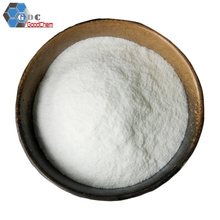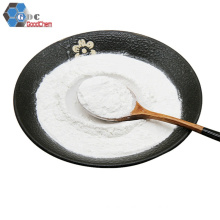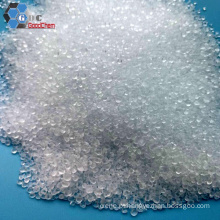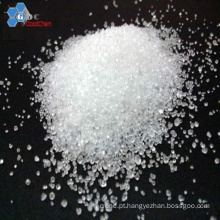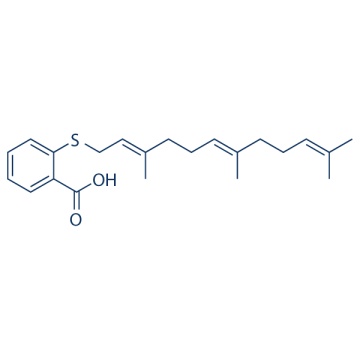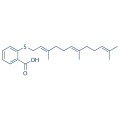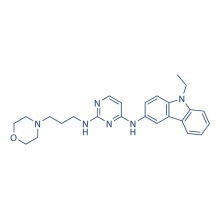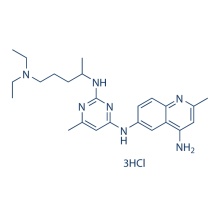.cp_wz table {border-top: 1px solid #ccc; border-left: 1px solid #ccc; } .cp_wz table td {border-right: 1px solid #ccc; borda inferior: 1px sólido #ccc; preenchimento: 5px 0px 0px 5px;} .cp_wz tabela th {border-right: 1px solid #ccc; border-bottom: 1px solid #ccc; preenchimento: 5px 0px 0px 5px;} \ n Peso molecular: \ n 358,54 Salirasib é um potente inibidor competitivo da proteína metiltransferase prenilada (PPMTase) com Ki de 2,6 μM, que inibe a metilação de Ras. Fase 2. \ n Atividade biológica O salirasib inibe o crescimento de células Rat1 transformadas por Ha-ras humanas, que se correlaciona bem com sua inibição para PPMTase. Salirasib inibe a metilação de Ras em fibroblastos Rat-1, Rat-1 transformados com Ras e células de melanoma B16. O salirasib também reduz os níveis de Ras nas membranas celulares e inibe o crescimento celular dependente de Ras, independentemente da metilação, mas através da modulação da comunicação Ras-Raf. Em células EJ transformadas por Ras, o Salirasib interfere na ativação de Raf-1 e MAPK e inibe a síntese de DNA. Em camundongos nus com xenoenxerto Panc-1, Salirasib (5 mg / kg ip) inibe marcadamente o crescimento do tumor sem toxicidade sistêmica. Em ratos Wistar machos, Salirasib (5 mg / kg ip) inibe marcadamente a cirrose hepática induzida por tioacetamida. No modelo de camundongo dy (2J) / dy (2J) de distrofia muscular congênita, Salirasibe (5 mg / kg ip) atenua a fibrose e melhora a força muscular. Ensaio de cinase de protocolo (apenas para referência): [2]
|
PPMTase Assays
|
Synaptosomal membranes of rat brain cerebellum or total membranes of cultured cell lines (100,000 × g pellet) are used for methyltransferase assays in the cell-free systems. Methyltransferase assays are performed at 37°C in 50 mM Tris-HCl buffer, pH 7.4, using 100 μg of protein, 25 μM [methyl-3H]AdoMet (300,000 cpm/nmol), and 50 μM AFC (prepared as a stock solution in DMSO) in a total volume of 50 μL. DMSO concentration in all assays is 8%. Various AFC concentrations are used in several experiments as indicated in the text. Reactions are terminated after 10 min by addition of 500 μL of chloroform:methanol (1:1) with subsequent addition of 250 μL of H2O, mixing, and phase separation. A 125-μL portion of the chloroform phase is dried at 40°C, and 200 μl of 1 N NaOH, 1% SDS solution is added. The methanol thus formed is counted by the vapor phase equilibrium method. Typical background counts (no AFC added) are 50-100 cpm, while typical reactions with AFC yield 500-6,000 cpm. Assays are performed in triplicate, and background counts are subtracted. Methylation of endogenous substrates and gel electrophoresis are performed. Protein carboxyl methylation in intact cells is determined using 100 μCi/mL [methyl-3H]methionine. Cells are assayed in near confluent cultures grown in 10-cm plates with 5 mL of labeling medium.
|
Ensaio de células: [2]
|
Cell lines
|
PC12, CHE, T-antigen-transformed CHE, endothelial cells, astrocytes, B16, Rat1, EJ, NIH3T3, v-Raf-transformed NIH3T3 cell lines
|
|
Concentrations
|
~100 μM
|
|
Incubation Time
|
10 days
|
|
Method
|
Cells are grown in 24-well plates. 2 h after plating, the cells receive either solvent or FTS freshly prepared from a stock solution to yield the final indicated concentrations in 0.1% DMSO. Media are replaced every 4 days with fresh medium containing the solvent or the drug. Separate experiments indicate that the solvent itself has no effect on cell growth. On the indicated days, the cells are detached from plates by trypsin/EDTA and counted under the light microscope. All assays are performed in quadruplicate. In parallel experiments, cells are stained either with trypan blue or with MTT, and the stained cells are examined under the light microscope. In some MTT-stained cultures, the cells are dissolved in 0.2 mL of 100% DMSO, and the extent of staining is determined spectrophotometrically using an enzyme-linked immunosorbent assay reader.
|
Estudo Animal: [4]
|
Animal Models
|
Panc-1 xenografted nude mice
|
|
Formulation
|
Ethanol
|
|
Dosages
|
5 mg/kg daily
|
|
Administration
|
i.p.
|
Conversão de diferentes modelos de animais com base em BSA (valor com base em dados das diretrizes preliminares da FDA)
|
Species
|
Baboon
|
Dog
|
Monkey
|
Rabbit
|
Guinea pig
|
Rat
|
Hamster
|
Mouse
|
|
Weight (kg)
|
12
|
10
|
3
|
1.8
|
0.4
|
0.15
|
0.08
|
0.02
|
|
Body Surface Area (m2)
|
0.6
|
0.5
|
0.24
|
0.15
|
0.05
|
0.025
|
0.02
|
0.007
|
|
Km factor
|
20
|
20
|
12
|
12
|
8
|
6
|
5
|
3
|
|
Animal A (mg/kg) = Animal B (mg/kg) multiplied by
|
Animal B Km
|
|
Animal A Km
|
Por exemplo, para modificar a dose de resveratrol usada para um camundongo (22,4 mg / kg) para uma dose baseada na BSA para um rato, multiplique 22,4 mg / kg pelo fator Km para um camundongo e, em seguida, divida pelo fator Km para um rato. Este cálculo resulta em uma dose equivalente de rato para o resveratrol de 11,2 mg / kg.
|
Rat dose (mg/kg) = mouse dose (22.4 mg/kg) ×
|
mouse Km(3)
|
= 11.2 mg/kg
|
|
rat Km(6)
|
Informação Química
|
Molecular Weight (MW)
|
358.54
|
|
Formula
|
C22H30O2S
|
|
CAS No.
|
162520-00-5
|
|
Storage
|
3 years -20℃Powder
|
|
6 months-80℃in solvent (DMSO, water, etc.)
|
|
Synonyms
|
N/A
|
|
Chemical Name
|
2-((2E,6E)-3,7,11-trimethyldodeca-2,6,10-trienylthio)benzoic acid
|
Calculadora de molaridade Calculadora de diluição Calculadora de peso molecular
Grupo de Produto : Ciclo de célula > Inibidor Rho
